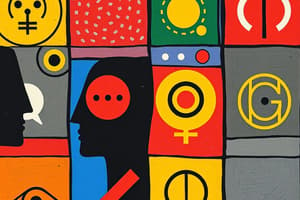Podcast
Questions and Answers
What is the primary function of symbols in human communication?
What is the primary function of symbols in human communication?
- To act as a direct reflection of an individual's internal thoughts.
- To facilitate understanding by representing concepts and ideas. (correct)
- To create a universal language that transcends cultural differences.
- To provide a standardized method for expressing emotions.
What is the primary characteristic of communication that emphasizes its ongoing, non-static nature?
What is the primary characteristic of communication that emphasizes its ongoing, non-static nature?
- Contextuality
- Self-reflectivity
- Dynamism (correct)
- Symbolism
Identify the factor that most significantly influences the meaning attributed to symbols in communication.
Identify the factor that most significantly influences the meaning attributed to symbols in communication.
- The specific occasion or event during which communication occurs.
- The number of participants involved in the communication.
- The physical environment where communication takes place.
- The cultural background of the individuals involved. (correct)
Which of the following is NOT considered a characteristic of communication as outlined in the text?
Which of the following is NOT considered a characteristic of communication as outlined in the text?
In the context of communication, what is the primary function of noise?
In the context of communication, what is the primary function of noise?
How does the self-reflective aspect of communication operate?
How does the self-reflective aspect of communication operate?
What does the statement "Communication always occurs in a context" convey?
What does the statement "Communication always occurs in a context" convey?
What is the role of the receiver in communication?
What is the role of the receiver in communication?
Which of the following is an example of internal noise in communication?
Which of the following is an example of internal noise in communication?
Encoding in communication refers to:
Encoding in communication refers to:
Which of the following is NOT considered a channel of communication?
Which of the following is NOT considered a channel of communication?
Feedback in communication is best described as:
Feedback in communication is best described as:
Examples of 'noise' in a communication event would include:
Examples of 'noise' in a communication event would include:
How does culture play a role in communication?
How does culture play a role in communication?
Which factor is MOST directly linked to the success of communication?
Which factor is MOST directly linked to the success of communication?
What is the primary difference between encoding and decoding in communication?
What is the primary difference between encoding and decoding in communication?
What is the main purpose of communication according to the text?
What is the main purpose of communication according to the text?
How does communication assist in person perception?
How does communication assist in person perception?
What does the text say about how communication shapes our identity?
What does the text say about how communication shapes our identity?
What does the text imply about the nature of communication?
What does the text imply about the nature of communication?
How does communication act as a means to regulate the world around us?
How does communication act as a means to regulate the world around us?
What is the role of a source in communication?
What is the role of a source in communication?
How does the text define communication?
How does the text define communication?
What is the significance of the 126 definitions of communication found by Dance and Larson?
What is the significance of the 126 definitions of communication found by Dance and Larson?
Which of these statements accurately describes the concept of communication being irreversible?
Which of these statements accurately describes the concept of communication being irreversible?
What is the key implication of communication's consequential nature, as discussed in the text?
What is the key implication of communication's consequential nature, as discussed in the text?
In the context of communication being complex, how does Wood's statement, 'What we say and do affects others: how they perceive themselves, think about themselves and how they think about others,' support this idea?
In the context of communication being complex, how does Wood's statement, 'What we say and do affects others: how they perceive themselves, think about themselves and how they think about others,' support this idea?
What is the primary misconception addressed regarding communication?
What is the primary misconception addressed regarding communication?
Why does the text argue that the statement 'Some people are born effective communicators' is a misconception?
Why does the text argue that the statement 'Some people are born effective communicators' is a misconception?
Which of the following is NOT a characteristic of communication mentioned in the text?
Which of the following is NOT a characteristic of communication mentioned in the text?
What is the primary point made about the complexity of communication?
What is the primary point made about the complexity of communication?
What is the impact of cultural differences on communication?
What is the impact of cultural differences on communication?
What is the main implication of the statement, “Communication can involve controlling, informing, persuading, and relating to others”?
What is the main implication of the statement, “Communication can involve controlling, informing, persuading, and relating to others”?
Flashcards
Communication
Communication
The ability to share ideas and feelings, forming the basis of human contact.
Interpersonal Needs
Interpersonal Needs
The human need to communicate to satisfy emotional and social requirements.
Person Perception
Person Perception
The process of gathering information about others when communicating.
Cultural Identity
Cultural Identity
Signup and view all the flashcards
Personal Identity
Personal Identity
Signup and view all the flashcards
Dynamic Identity
Dynamic Identity
Signup and view all the flashcards
Persuasive Communication
Persuasive Communication
Signup and view all the flashcards
Source in Communication
Source in Communication
Signup and view all the flashcards
Irreversible Communication
Irreversible Communication
Signup and view all the flashcards
Consequences of Communication
Consequences of Communication
Signup and view all the flashcards
Complexity of Communication
Complexity of Communication
Signup and view all the flashcards
Cultural Influence on Communication
Cultural Influence on Communication
Signup and view all the flashcards
Misconception: Communication Solves Everything
Misconception: Communication Solves Everything
Signup and view all the flashcards
Misconception: Born Communicators
Misconception: Born Communicators
Signup and view all the flashcards
Learning from Communication
Learning from Communication
Signup and view all the flashcards
Communication's Impact
Communication's Impact
Signup and view all the flashcards
Encoding
Encoding
Signup and view all the flashcards
Messages
Messages
Signup and view all the flashcards
Channel
Channel
Signup and view all the flashcards
Receiver
Receiver
Signup and view all the flashcards
Decoding
Decoding
Signup and view all the flashcards
Feedback
Feedback
Signup and view all the flashcards
Noise
Noise
Signup and view all the flashcards
Nonverbal Symbols
Nonverbal Symbols
Signup and view all the flashcards
Noise in Communication
Noise in Communication
Signup and view all the flashcards
Dynamic Process
Dynamic Process
Signup and view all the flashcards
Irretractable Actions
Irretractable Actions
Signup and view all the flashcards
Symbolic Communication
Symbolic Communication
Signup and view all the flashcards
Cultural Perspective
Cultural Perspective
Signup and view all the flashcards
Contextual Communication
Contextual Communication
Signup and view all the flashcards
Participants in Communication
Participants in Communication
Signup and view all the flashcards
Self-Reflective Communication
Self-Reflective Communication
Signup and view all the flashcards
Study Notes
Culture and Communication
- Intercultural interaction relies on communication.
- Communication is the foundation of all human contact, allowing people to share ideas and feelings.
The Uses of Communication
- Communication fulfills interpersonal needs as humans are social creatures.
- Individuals require communication even in solitary confinement.
- People need to communicate and interact with others.
Communication Assists with Person Perception
- Communication helps gather data about others.
- Initial interactions involve collecting information about others.
- This information serves two purposes: enabling understanding of the other person and guiding how to present oneself.
- Verbal and nonverbal information is crucial in initial interactions
Communication Establishes Cultural and Personal Identities
- Communication shapes personal identities.
- Interactions with others provide information to define identity, belonging, and loyalties.
- Identity is complex and ever-evolving, influenced by self-concept, family ties, gender views, cultural beliefs, and experiences.
Communication Has Persuasive Qualities
- Verbal and nonverbal messages shape behavior.
- Daily interactions, such as selling and charitable causes, influence others.
- Communication decisions, from discussion topics to conversation endings, are ways to control the world around us.
Defining Communication
- Numerous definitions of communication exist.
- Communication is considered a dynamic process where people exchange thoughts and feelings through symbols in specific situations.
The Components of Communication
- Source: Person with an idea, feeling, or experience who wishes to share it.
- Source acts as both sender and receiver in communication.
- During communication, the source is actively observing the message received by their communication partners
The Components of Communication: Encoding
- Encoding uses symbolic representations of internal states.
- It is an internal process where the source selects verbal and nonverbal symbols to express the message.
- Vocabulary, grammar, and syntax are based on the source's language and shape the message, with roots in the culture of the language used.
The Components of Communication: Messages
- Messages are a collection of written, pictorial, verbal, or nonverbal symbols representing a particular internal state at a specific moment.
- The act of sending messages is an external process, embodying the subject intended to be communicated.
The Components of Communication: Channel
- Channels facilitate communication between individuals.
- Channels include face-to-face interactions (sight and sound), media (TV, internet).
- Different channels transmit messages from one location to another.
The Components of Communication: Receiver
- Receiver is the person who considers the message from the source.
- Receivers become part of the interactive communication process.
- The receiver decodes the message within an information processing stage, understanding the communication from sender's perspective.
The Components of Communication: Feedback
- Feedback is the response to a message that the sender interprets.
- Feedback can take the form of verbal messages, non-verbal cues, or even silence.
- The perception of the response determines feedback. Feedback is often used to determine future course of action for the interaction.
The Components of Communication: Noise
- Communication events always consist of competing stimuli.
- Noise is any unintended stimulus that interrupts the communication process.
- Noise can be of both internal and external factors affecting interaction.
Characteristics of Communication: Dynamic
- Communication is a continuous process without beginning or end.
- It's not static, like a snapshot, but more like a movie.
- Actions and words can't be undone; once shared, they have an impact on the recipient.
Characteristics of Communication: Symbolic
- Communication uses symbols to represent something else.
- Symbols, used in human interaction, convey meaning.
- Humans create, receive, store, and manipulate symbols.
- Different people interpret symbols based on their unique cultural experiences.
Characteristics of Communication: Contextual
- Communication always occurs in a context.
- Context like the environment, occasion, and participants influence communication.
- The contextual setting affects how messages are interpreted.
Characteristics of Communication: Self-Reflective
- Communication involves observing and evaluating one's interaction.
- Individuals form self-assessments in the midst of communication and make adjustments in real-time.
- Individuals consider their communication in the moment.
Characteristics of Communication: Irreversible
- Communication is irreversible; once a message is sent, it can't be taken back.
- Messages have an enduring impact on the receiver, regardless of their context.
Characteristics of Communication: Consequential
- Communication always has consequences, influencing people's actions.
- Receiving messages shapes interaction and beliefs about oneself and others.
- Interactions cause lasting impacts which create an influencing effect.
Characteristics of Communication: Complex
- Communication includes various activities like controlling, informing, persuading, and relating.
- Communication includes bodily and mental processes.
- Multiple factors, like cultural nuances, make communication complex.
Misconceptions about Human Communication
- Communication is not a solution to all problems, especially personal relationships.
- Not all cultures have the same communication expectations.
- Human communication is influenced by context and varies significantly across cultures.
- Effective communication is not necessarily innate but can be learned.
- The message sent is not always the message received; several factors, including the recipient's background, influence perceptions, impacting communication.
Studying That Suits You
Use AI to generate personalized quizzes and flashcards to suit your learning preferences.




